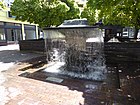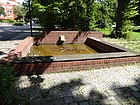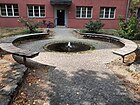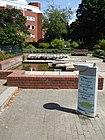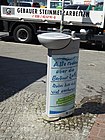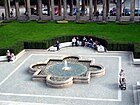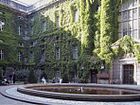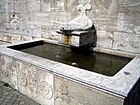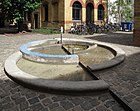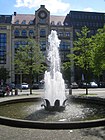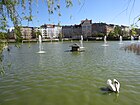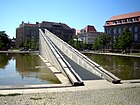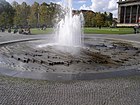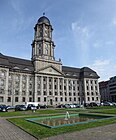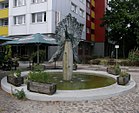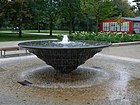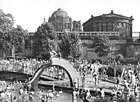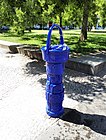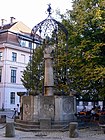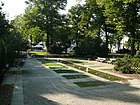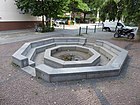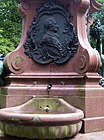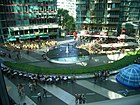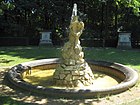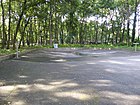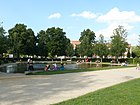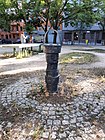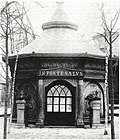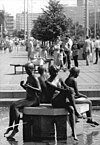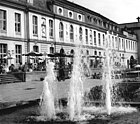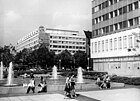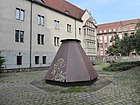List of fountains in the Mitte district of Berlin
The list of fountains in Berlin 's Mitte district is an overview of the currently (as at: September 9, 2017) existing 87 fountains , water plants and ornaments public splash in all the districts of the central district. Not included are designed water basins in which there is no moving water.
Especially in the historic city center of Berlin , in connection with the extensive construction activity, the municipal authorities saw it early on to influence the artistic design of the public spaces and facilities. After the first isolated activities to maintain existing works of art (especially monuments), a “Municipal Deputation for Art Purposes” was established on November 13, 1893, consisting of five members of the magistrate and ten city councilors. This art commission received an annual art fund, which initially amounted to 100,000 marks (adjusted for purchasing power in today's currency: around 695,000 euros). Competitions could be initiated, juries financed and orders placed or works of art purchased. As a result, until the 1930s Berlin had , among other things, almost 100 decorative plants, mostly green spaces with flowers, fountains, monuments and small functional buildings.
According to the Senate , Berlin has a total of 270 ornamental fountains and sea fountains, the maintenance of which will be taken over by Berliner Wasserbetriebe from 2017 .
The second part of the list contains the no longer existing fountains and water features in the Mitte district.
Fountain in the center of Berlin
The list is pre-sorted according to the districts, followed by the names of the wells (alphabetically), but can also be sorted individually according to street / location, artist or the year of commissioning.
- Explanations
- The abbreviations for the districts mean:
- Gb = Berlin-Gesundbrunnen , Ha = Berlin-Hansaviertel , Wed = Berlin-Mitte , Mon = Berlin-Moabit , Tg = Berlin-Tiergarten , We = Berlin-Wedding
- The names of the fountains are written in italics as given by the artist, the rest are descriptive (unofficial) names.
- If several artists were involved in the drafts, sorting can only be made according to the first named.
| District | Name of the well |
Address location |
Draft (artist) | Year of construction / inauguration | Image and abstract |
|---|---|---|---|---|---|
| Gb | Beaver fountain | Rose garden in the Humboldthain location |
Max Rose | 1965 |
After the commissioned work had been completed, the fountain was first installed in the Rehberge park . Here it suffered multiple damage, so that the Wedding District Office at that time restored the jewelry fountain and had it moved to Humboldthain in 1980. One of limestone worked Biber , 80 cm high, is almost rectangular base made up of such material. From the base under the animal's front paws, water flows into a round, spiral-shaped basin set into the ground, which measures 2.60 m in diameter. The fountain bowl, made in rings, consists of granite mosaic. |
| Gb | Brunnella | Brunnenstraße 74, next to the restaurant "Volta" position |
Paul Pfarr 1966/1967 | 1982 |
The district management of Brunnenviertel and the owner and operator of two fountain systems, DeGeWo , have selected the names Brunnella and Brunno from the proposed names for the decorative fountains . The fountain consists of a vertical stone column, which is provided with a rectangular shaped copper roof. From the 'eaves' water trickles into a rectangular basin below street level. The design comes from Paul Pfarr 1966/1967, executed in 1982, collaboration: Dirk Eversberg |
| Gb | Fountain in the courtyard | Fordoner Strasse / Heubuder Strasse / Koloniestrasse / Stockholmer Strasse | Rudolf Maté | 1930 | |
| Gb | Well bowl with fountain on Brunnenplatz |
Brunnenplatz location |
Michael Hennemann | 1987 |
A multi-jet fountain gushes up to six meters high in a round, ground-level granite basin, 13 m in diameter. The nozzle is located in a small stone base one meter in diameter. |
| Gb | Brunno | Brunnenstrasse 64 location |
unknown | 2003 |
Brunno got its name as a counterpart to Brunnella. The water art work consists of two octagonal low well basins (one with sides of the same length and one with sides of different lengths, which are more like a long rectangle). From low copper pipes, which are bent slightly towards the center at the corners of the basin, jets of water spray against one or two vertical stone pillars, which are also octagonal. The operator is the aforementioned housing company. The fountain basins are laid out with small paving stones. |
| Gb | Historic pump |
Badstrasse corner Buttmannstrasse location |
Otto Stahn | 1892 |
One in Berlin slang loosely called "Crude" Handschwengelpumpe is restored in the Badstraße. The official name is public street fountain with impregnation stone . The pumps installed in what was then Berlin's urban area at the end of the 19th century were made of iron in the Lauchhammer foundry, hence the name Lauchhammer pumps. They are richly decorated with ornaments and depictions of animals. This work is a listed building . |
| Gb | Historic pump | Volkspark Humboldthain | Otto Stahn | around 1892 |
Another “plump” can be found in Volkspark Humboldthain. It belongs to the Lauchhammer pumps, decorated with ornaments and depictions of animals. It was installed in its current location in 1978 and is a listed building. |
| Gb | Historic pump |
Putbusser Strasse location |
Otto Stahn | around 1892 |
Another Lauchhammer pump, adorned with ornaments and depictions of animals, stands in front of the property on Putbusser Strasse. It was installed in its current location in 1978 and is a listed building. |
| Gb | Hippopotamus fountain | Vinetaplatz location |
Hans-Peter Flechner | 1983 |
The 50 centimeter high head of a hippopotamus made of sandstone is attached to the side of a square, brick-built and clinkered basin . Water flows from its mouth into the basin, which touches a higher plant basin made of the same material. Wooden gratings are installed on part of the edge of the water basin as seating. Length and width of the pool: 4 m × 4 m, height of the pool edge: 45 cm / 85 cm, width of the pool edge: 40 cm, the pool floor consists of granite slabs and small stone paving.
|
| Gb | Threshold well | Vinetaplatz location |
Hans-Peter Flechner | 1982 |
Three staggered rectangular pools of different sizes (5.30 m × 4.20 m; 4.20 m × 1.60 m; 8.60 m × 1.80 m) are separated from one another by narrow sidewalks. The pool walls are 40 cm high and 35 cm thick, so that the edges offer seating. The water flows over roughly hewn granite thresholds that are loosely laid in the basin, creating a calm water oasis. The floors of the water basins are made of paving stones , the pool edges are clad with clinker bricks. |
| Gb | fountain | Heidebrinker Strasse, in the garden city Atlantic location |
Rudolf Fränkel (architect) | around 1925 |
A central fountain gushes from a round water basin at ground level. The facility is located in the middle of a small green area and is surrounded by two semicircular long benches. The fountain was probably built at the same time as the housing estate was built. It was renovated together with the residential buildings in the 2000s. |
| Gb | Drinking water well, type 2 | Vinetaplatz location |
Berliner Wasserbetriebe | 2017 |
The new installation of free drinking water wells on public streets and squares in Berlin is a typical development of the time. The systems last installed in 2016/2017 are the result of a sponsorship by the water company with the organizers of the Brunnen Run mass run : registered runners symbolically paid for the fountain campaign with the kilometers they covered. In total, Berlin received four new drinking water wells during the course of 2016, two of them in the Gesundbrunnen district. |
| Gb | Drinking water well, type 1 |
Badstrasse and Prinzenallee Lage |
Berliner Wasserbetriebe | 2014 |
The popular drinking fountain is at the entrance to the Pankstraße subway station. |
| Gb | Drinking water well, type 2 |
Berlin-Gesundbrunnen train station , Badstrasse corner Behmstrasse location |
Berliner Wasserbetriebe | 2017 |
Set up on the basis of sponsorship between the water companies and the organizers of the Brunnen Run mass run . |
| Gb | Water fountain |
Volkspark Humboldthain location |
A compact, round hill about 40 cm high and (estimated) around two meters in diameter was formed from small paving stones. From the middle, in which a nozzle is surrounded by three natural stones, water flows off on all sides over the little hill. For the purpose of drainage, the water fountain is surrounded by a flat channel, also made of small paving, in a ring shape. This rather inconspicuous fountain system (not listed in the Senate Administration's file) also serves as a watering place for the birds and small animals in the park. |
||
| Ha | Training flight | Lessingstrasse 5 At the Hansa primary school in Lage |
Otto Douglas Douglas-Hill | 1958 |
A larger and a smaller figure, reminiscent of dolphins, rise from a crescent-shaped pool of water. The figures are made of fired ceramic, a material that Douglas-Hill frequently uses. |
| Ha | Schifferbrunnen |
Spree bank north of the Hansabrücke location |
Hermann Hosaeus | 1914 |
A stone column about one meter high is located in a polygonal, approximately round, flat fountain bowl. Modeled on it is a singing boatman with an accordion and in typical clothing of the time, who sits on a bollard. The sandstone fountain sculpture refers to the life of the boatmen who used to work on the Spree and who handled the transport tasks for the big city. The fountain is listed as a cultural monument . However, no more water flows from it, the basin is planted.
|
| Wed | Agatha fountain |
Grosse Hamburger Strasse 5–11, courtyard of the St. Hedwig Hospital Lage |
Jens-Hagen Engelhardt | 1996 |
The fountain stands at a point where there was already a fountain from 1890 to 1905. The Moorish-style fountain was inaugurated in the front courtyard of the hospital on September 14, 1996 for the 150th anniversary of the hospital by Archbishop Georg Cardinal Sterzinsky .On a base about 3 m in diameter stands a bowl that dispenses water on four sides. On the bowl there is a statue of Agatha of Catania .
There is also a bronze fountain in the courtyard. |
| Wed | Bear fountain |
Werderscher Markt location |
Hugo Lederer |
1928, 1958 recreated according to old plans |
A she-bear with her cubs is depicted on an octagonal platform, 70 cm high. The facility stands in front of the Friedrichswerder Church . It is made of red lava tufa stone . The fountain was rebuilt by Walter Sutkowski on behalf of the East Berlin magistrate in 1958, as the original had been destroyed by fighting at the end of the Second World War. |
| Wed | Fountain in the Brunnenhof (Courtyard IV) |
Hackesche Höfe , Rosenthaler Strasse location |
unknown | unknown |
A central fountain bubbles in a small, round, slightly shaped granite basin. The complex is in the shade of a conspicuously sloping ash-maple . |
| Wed | Fountain on the Charité Mitte campus |
Virchowweg on the Charité-site location |
On the square between the Max Planck Institute for Infection Biology and the CharitéCrossOver building there is a quiet zone with beds and fountains. Natural stones are arranged in a round basin measuring approx. 5 m from which a fountain gushes. |
||
| Wed | Fountain on Schinkelplatz |
Schinkelplatz location |
Hans Starcke (acanthus motif) | 2008 |
In the center of a circular bowl (concrete painted gray, 50 cm high, 40 cm wide, the edge is covered with reddish Swedish granite) an acanthus wreath is installed from which fountains can rise. The height of the water jet can be controlled depending on the wind. A small circular lawn is bordered by a low cast-iron fence. The fountain, newly created in 2008, is based on its historical model, which was erected in front of the Bauakademie around 1885. |
| Wed | Fountain of friendship between nations |
Alexanderplatz location |
Walter Womacka , executed by Hans-Joachim-Kunsch | Nov 1970 |
The basin has a diameter of 23 m, the central water spiral made of chased copper is 6.20 m high. The basin is decorated with glass crystals, colored enamel and colored tiles; the entire fountain system is a listed building . |
| Wed | Fountain in the colonnaded courtyard of the Alte Nationalgalerie |
Museum Island , in front of the Alte Nationalgalerie location |
Eduard Neide | 1880 |
The fountain, which is centrally located in front of the stairs of the Alte Nationalgalerie, has a four-pass sandstone basin with a diameter of approx. 10 m, in the middle of which a fountain gushes. The fountain was created in this form in the 1880s by Eduard Neide (1818–1883), a student of Peter Joseph Lenné , who also planned the green areas of the colonnaded courtyard. The colonnaded courtyard was restored when the reconstructed house opened in October 2009. The fountain is part of the garden monument in front of the National Gallery . |
| Wed | Fountain in the State Library |
Unter den Linden 8 location |
Ernst von Ihne (architect of the entire building complex) | 1914 |
In the courtyard capped stone fountain in a circular pool (about ten meters in diameter). |
| Wed | Fountain in the old town house | Klosterstrasse 47 location |
Ignatius Taschner | 1911 | The fountain in the vestibule of the old town house was lost in 1945 and was reconstructed during the renovation of the building in the mid-1990s. The marble fountain from Rosso Verona with the figure of the "Fischbuberl" consists of four parts. The monolithic water basin has a total weight of more than two tons. |
| Wed | Well in the Federal Ministry for Economic Affairs and Energy | Scharnhorststrasse 34–37 location |
Annette Sauermann | 2000 |
As part of the renovation of the former Kaiser-Wilhelms-Akademie , the fountain by the Essen artist Annette Sauermann was created in the Goerckehof in 2000. A basin with a diameter of approx. 10 m is divided into two spirals lying one inside the other, in which the water flows around the center in opposite directions. In the evening the water is illuminated by blue fluorescent tubes. |
| Wed | Well in the Federal Ministry for Economic Affairs and Energy | Scharnhorststrasse 34–37 location |
Reinhold Felderhoff | 1910 |
At the corner of Invalidenstrasse and Scharnhorststrasse is the fountain integrated into the front of the house with depictions of ancient figures and two fountain basins lying one above the other. |
| Wed | Well in the Federal Ministry for Economic Affairs and Energy | Scharnhorststrasse 34–37 location |
Knippschild & Simons | 2000 |
The so-called Kanonenhof with the historical fountain was restored when the garden was redesigned by the garden architects Knippschild & Simons. The planning goes back to the horticultural designed inner courtyard in 1822, the design of which is attributed to the garden architect Peter Joseph Lenné . The fountain has a bowl about 7 m in diameter sunk into the ground, in the middle of which a fountain about 1.50 m high gushes from a pile of stones. |
| Wed |
Butt wells also clod on dry land |
Museum Island , west of the Altes Museum location |
Robert Schirmer | 1916 |
Right next to the Iron Bridge , a staircase leads to a small oasis of calm. Here the visitor notices a wall fountain, which is worked as a clod of limestone attached to the bridge wall. A fine jet of water runs out of the open mouth of the fish (width and height 70 cm by one meter). The 3.20 m wide, 1.70 m high and 77 cm deep fountain basin is decorated with flower ornaments. |
| Wed |
Fontes e sequestros (Eng: sources and kidnappings ) |
Linienstraße 155, inner courtyard location |
Renata Lucas | 2015 |
Patterned structures of three Berlin fountains from different architectural epochs form a new abstract work of art. The Brazilian artist refers to the Triton Fountain ( Großer Tiergarten , 1888), the Eva Fountain ( Alt-Tempelhof , 1927) and the dance of the youth (Marzahn, Pekrunstraße , 1984) |
| Wed | Money counter well |
Poplar square location |
Ernst Wenck | 1912 |
In an octagonal well basin there is a higher rounded basin. In it, a naked athlete kneels on a square well pillar in a money counter pose. The fountain was extensively renovated in 2006. The shell limestone basin has a diameter of 2.55 m and sides of 1.26 m. The well stock is 1.85 m high, the total height is 3.25 m. |
| Wed | Historic pump |
Arkonaplatz location |
unknown | around 1890 |
The sandstone basin is 2.50 m long, 1.50 m wide and 80 cm high. The cast iron hand pump is a restored original from the 19th century; it is 2.90 m high and donates drinking water . |
| Wed | Historical fountain (drinking fountain) at the restaurant "Zum Paddenwirt" |
Eiergasse location |
unknown | 1987 |
A dark pink marble from existing octagonal fountain pool (diameter 1.40 m), which is 95 cm high, stands on a low pedestal also octagonal sandstone. The outside of the pool is decorated with acanthus leaves. On the front side is the bas-relief of a coat of arms with a bird of prey above it. The blacksmith Hans-Joachim Kunsch added wrought iron decorations to the fountain : a grid cover, a metal arch and two copper water dispensers. |
| Wed | Historical fountain on Hausvogteiplatz |
Hausvogteiplatz location |
Willnecker and Siegmann (overall design), Dietrich Starke (crown of leaves), Kraas company (casting of crown of leaves) |
Newly manufactured and inaugurated in 1890 : June 20, 2003 |
In 1890, a round ornamental fountain was put into operation on Hausvogteiplatz. After the political change and the renovations in the city center of Berlin, the remains of the well were rediscovered during archaeological excavations. The city administration had the fountain rebuilt according to historical templates and inaugurated it in 2003 at the previous location. The round pool, made of Elbe sandstone and concrete, has a diameter of 7.90 m on the inside and 8.91 m on the outside. A water fountain rises up to four meters from a bronze crown of leaves in the middle of the basin, it is surrounded by ring fountains from which the rays can rise up to two meters. |
| Wed | Indian fountain and angel basin |
Luisenstädtischer Kanal , Michaelkirchplatz location |
Gerald Matzner, Kraas company | 1995 |
Octagonal basin with a diameter of approx. 5 m, inside two stepped also octagonal basins. There is a five-tier cascade column on top of which a bronze temple dancer sits. The individual drainage bowls are decorated with lion heads on the sides. The fountain sculpture is a total of 2.20 m high. The inside of the natural stone basin is covered with gold mosaic. In the summer of 2004, a large fountain (height of the water column more than 8 m) was put into operation in the Engelbecken. When the Senate decided to partially dismantle the Engel basin, the fountain gave way to two rows of eight smaller fountains in the original shape. |
| Wed | Small love column | Dorothea-Schlegel-Platz / Georgenstrasse location |
Achim Kühn |
1981, erected in 1983 and re-inaugurated on July 16, 2004 |
A phallus symbolically made of chased copper stands in a ground-level, slightly sunken water bowl measuring six by 6 m. The sculpture is 2.50 m high, from its upper end as well as from two further rings in the middle and in the lower part uniform jets of water emerge from gold-plated nozzles. In 1999 the fountain, which stood in a small green area on Clara-Zetkin-Straße (now renamed back to Dorotheenstraße), was stolen there. After the redesign of the area surrounding the Friedrichstrasse station , the construction company Züblin acted as a sponsor and had a second sculpture made in Kühn's workshop based on old templates, which was now placed on the new town square. |
| Wed | Market hall fountain | Rosa-Luxemburg-Strasse location |
Gerhard Thieme | 1973 |
The ornamental fountain with a representation of old Berlin figures (flower woman, sausage maxi, vegetable woman, fish seller, tailor and farmer as well as a small dog) is located between the former central market hall and the tram route . The pool with a diameter of 4.50 m and the base are made of artificial stone and concrete. The group of figures is located on a well, the surface of which is decorated with small mosaic. The water trickles in six fine jets from the floor of the group of figures. |
| Wed |
Wall fountain , Girot water system, also Sunken Wall |
Invalidity parking on Invalidenstrasse corner Scharnhorststraße location |
Christophe Girot | 1997 |
The water-bearing pool is 62 meters long and 50 meters wide. At the edge, parallel to the course of Invalidenstrasse, a wall is made of granite , which is about seven meters high on one narrow side, on the opposite side it "sinks" into the water. A footpath runs along the wall and ends on a small viewing area. The water flows steadily down the towering narrow side of the wall, which is clad with slate. |
| Wed | Modern fountain |
Lustgarten location |
Hans Loidl | 2000 |
Fountains in a flat bowl, the bottom of which is designed with broken strips. A central nozzle can let the water rise up to ten meters high, around it 20 vortex nozzles are grouped, which form a 3.50 m high and 2 m wide dense cone of water above the fountain bowl. The diameter of the basin is 15 m, it is 25 cm deep and consists of shell limestone. There were already fountains in the same place in the 19th century . |
| Wed | Molkenmarktbrunnen | Molkenmarkt / Grunerstraße, in front of the old town house Lage |
Berliner Wasserbetriebe |
1969 renewed 2004 |
Electronically controlled water jets with a higher central fountain rise from a round spring jet, which is incorporated as a copper circle in a rectangular pool made of polyester and concrete (dimensions: 7 m × 5 m). A total of three similar pools are arranged like a chessboard in a meadow, interrupted by narrow footpaths between the pools and the green areas of the same size. The wind-dependent control is carried out by means of a wind turbine at the top of a flagpole near the well basin. |
| Wed | Fountain of Neptune |
Spandauer Straße , open space TV tower location |
Reinhold Begas | 1891 |
Former palace fountain, which initially stood on the south side of the Berlin Palace on Schlossplatz . The commissioned work by the Berlin magistrate, modeled by Begas on the Four Rivers Fountain by Bernini Rome, was a gift from the city to Emperor Wilhelm II. In the original installation, Neptune looked into the Empress’s bedroom, which is why it was shot. In 1969 it was given its current location near the Red City Hall and was integrated into the surrounding green area after the Berlin television tower was built. The relocation to its historical location on Schlossplatz is a controversial issue. |
| Wed | Peacock fountain | Holzmarktstrasse, opposite the Jannowitzbrücke train station | Margit Schötschel-Gabriel | 1979 |
The round pool (6.50 m diameter) is made of concrete, the 3.50-meter-high fountain Stock is molded from natural stone, on the three interlocking peacocks taps of bronze stand. Fine jets of water spray from their head feathers. more pictures |
| Wed | Splash | Weydemeyerstrasse | unknown | around 1960 |
Angled nozzles arranged in a circle created a water dome with a larger diameter. The splash has been closed since 2013 because the facility is ailing. The planned reconstruction work was constantly delayed due to a lack of funding. In 2016, however, it was to be converted into a water playground, which the landscape architect Wolf Ahner planned. For various reasons, the drafts only met with cautious approval from the residents. At the beginning of July 2017, regional television reported that the money had now been made available and that the renovation would be ready in week 32, 2017. No reconstruction work had been carried out up to October 2017, the paddling pool is now overgrown. Only a mobile site fence blocks the area (to be seen on the right side of the picture). In the summer of 2018, the pool was completely rebuilt, with an additional stainless steel spray shower. |
| Wed | Splash at the Nordbahnhof, Invalidenstrasse | Invaliden corner Eichendorffstrasse | around 1958, renewed in 2014 after completion of construction work |
The water system, which is especially intended for small children and is the responsibility of the district office in the center, sprays from some emerging stainless steel elements (pumps, jet showers or large fish) by means of a timer; it can also be operated by the users themselves. The very shallow basin has a rough surface. Before, there was a simple blue paddling pool at this point. |
|
| Wed | Splash in the Volkspark Weinbergsweg |
Volkspark am Weinberg location |
unknown | unknown |
Simple geometric bodies (spheres, cuboids, cones and pyramids) made of stainless steel, granite, artificial stone and concrete are stored in and around a flat 10 m × 10 m large concrete basin. They are up to 1.60 m high and can be used for climbing. The water runs off into a basin of the same size with a small seat edge connected via a corner. Parts of the system had to be replaced in 2016. |
| Wed | Romantic wall fountain | Reinhardtstrasse / Luisenstrasse ( Charité site ) | unknown | in the 19th century | A small ensemble of red-flamed marble is installed on a smooth wall near the monument to Albrecht von Graefe . A semicircular sink, the upper edge of which is corrugated, serves to catch the water. Above the basin there is a bas-relief with a floating putto holding a water jug in his hands. A small jet of water flows steadily from this into the basin. |
| Wed | St. Wolfgang | St. Wolfgang-Strasse location |
unknown | 2004 |
This is a narrow, longer artificial watercourse along its entire length in the middle of the pedestrian zone. It is very flat, framed by metal grid plates and can be used by walkers or tourists. |
| Wed | Bowl fountain in Monbijoupark |
Monbijoupark at the corner of Oranienburger Strasse location |
Jasper Halfmann | 1995 |
The fountain, originally created for installation in the garden of the Prinzessinnenpalais in front of the State Opera building , is a cast iron cone standing on its tip with a diameter of three meters and a height of just over a meter. With the massive reconstruction of the opera house, the interesting fountain was given its new place in Monbijoupark in spring 2007. Already when the park was redesigned for the first time after the removal of the debris from the war, the construction collective H. Löffler / R. Schultz and E. Jaenisch set up a recreational sports facility with a paddling pool . This facility was removed with the complete redesign of the park in the mid-1990s. |
| Wed | Spindler Fountain |
Spittelmarkt location |
Walter Kyllmann , Adolf Heyden | 1892; at the historic location again since 1981 |
Basin: 10 m Ø, upper shell: 3 m Ø, lower shell: 4 m Ø, total height of the fountain: 6.50 m, material: Swedish rose-colored granite, set up in Volkspark Köpenick between 1927 and 1976 . |
| Wed | Drinking water well, type 1 |
Leipziger Platz location |
Berliner Wasserbetriebe | 2018 |
The popular drinking fountain is at the east end of Leipziger Platz on Leipziger Strasse. |
| Wed | Overflow stone | Lustgarten / Spreemauer; Kupfergraben location |
unknown | 19./20. century |
On both sides of a flat stone protruding from a 3 m high stepped round arch on the river wall, dolphin reliefs are incorporated. They take up the motif of the railing of the castle bridge ; In 1997 the well was renovated together with the entire bridge and the adjacent bank sections. Width of the round arches: approx. 3.10 m, height of the round arches: approx. 1.50 m |
| Wed | Wappenbrunnen , "founding well" |
in front of the Nikolaikirche location |
Günter Stahn (fountain), Gerhard Thieme (bear and reliefs), Hans-Joachim Kunsch (crowning), Stefan Kuschel (bronze chains) | 1987 |
On the occasion of the 750th anniversary of Berlin in 1987 was the East Berlin magistrate this commissioned to establish that the four trades of Berlin and Cölln symbolizes (butchers, bakers, shoemakers, drapers). |
| Wed | Water cascades on the television tower | Open space TV tower location |
Gottfried Funek (garden architect), Werner Stockmann (water features) The entire open space design was carried out according to plans by Walter Herzog (management) and Heinz Aust with a working group. |
May 1, 1972 |
Each of the eight pools is 21 m long and 8.70 m wide; it is made of concrete with a granite cladding. To the right and left of the stairs to the television tower are symmetrically arranged four elongated rectangular basins, in which a total of 560 nozzles are arranged. Time-controlled, these generate multi-level water cascades at different heights. The nozzles are distributed as follows: 88 for the water wall (11 per pool), 56 for the water columns (7 per pool), 256 for the bubble field (32 per pool) and 160 for the water arches (20 per pool). Between 2005 and 2007, both the structural system and the water systems were completely renovated. In the dark, the water features are illuminated in color by 296 underwater spotlights. |
| Wed | Two historical fountains on Pariser Platz |
Pariser Platz location |
Dietrich Starke (draft), Kraas company (cast) | 1992 |
The two fountains were created with the reconstruction of the buildings around the Brandenburg Gate after the political change based on old models. The diameter of the natural stone basin is ten meters, the bronze crowns made of acanthus leaves have a diameter of 2.30 m, in the middle there are symmetrical small fountains. |
| Mon | Fountain in front of the "Spree-Bogen" office center |
Alt-Moabit 101 location |
Stephan Haan | 1997 |
In the central axis of the office building, which opens onto the Spree , there are two fountains designed by landscape planner Stephan Haan, which were created when the building complex was erected. The front fountain is made of polished granite on which there is an illuminated granite ball with a diameter of 1.5 m on the slabs that rise slightly towards the center. The ball moves slightly due to the water pressure. It is surrounded by a circle of small fountains. The fountain further inside consists of a round basin measuring approx. Five meters in which four columns of different heights are made of glass plates, over which the water runs into the basin. |
| Mon | Five fountains in the Kleiner Tiergarten |
Small zoo location |
Willi Alverdes, Hans Nimmann | 1955 until 1960 |
The ensemble of fountains is made up of the following systems: an elongated rectangular water basin (19 m long, 1.65 m wide) made of concrete with nine evenly embedded water jets; a round concrete basin (4 m Ø) with a central fountain; another rectangular concrete basin (5.20 m long, 9.45 m wide) with a central fountain; a two-bowl fountain in which two clinkered, round-walled fountain basins (2.50 m Ø) each house an Eternit basin on a metal frame, all bowls are equipped with bubbling fountains; a three-bowl fountain - similar to the one mentioned above, made of Eternit and on metal frames - but with feet of different heights and standing next to each other. A small paving area serves as a common area. The ensemble is part of a cave garden in the park. On the website of the Senate Administration it says about the five wells in the Kleiner Tiergarten: “All five wells have been permanently removed. (Status: 2008) " |
| Mon | Historic pumps | Alt-Moabit , Wiclefstrasse, Wilhelmshavener Strasse, Lübecker Strasse | around 1892 |
There are several historical water pumps in the Moabit district, such as B. in Alt-Moabit opposite the Spreebogen (renovated in 1978), in front of Wiclefstraße 1, in front of Wilhelmshavener Straße 22 and in Lübecker Straße. |
|
| Mon | Paech fountain |
Stephanstraße 38–43 in the Stephankiez location |
Brigitte Haake-Stamm |
1980 since 2010 behind the Moa arch, in front of the brush house |
The bread manufacturer Paech had a decorative fountain set up on his factory premises. The round concrete basin (4.50 m Ø) is set into the ground. In the middle of the pool there is a round (1.60 m Ø) base. There are two naked female figures with a child and a cat, next to it a 2.40 m high twisted bronze column in the form of an abstract tree rises. Breads and pretzels are draped on the tree, a woman is holding a bread plate on her knees, the child is playing with bread rolls. At the fountain there is the quote on a bronze plate: "Bread - a blessing of the earth" and the year 1980. The water flows into the basin from the two upper branches of the screw tree and from fish heads that protrude from the base. The fountain was dismantled between April 2004 and autumn 2010 because new commercial buildings were being built on the area. |
| Mon | Fountain - natural stone plant | Waldstrasse / Waldenserstrasse location |
unknown | 1983 |
An octagonal basin with an inner diameter of around 2.50 m made of light gray granite is ring-shaped by an interrupted bench made of the same material with a seat back. A fountain gushes about 60 cm high from the middle of the basin. |
| Day | Ammonite fountain |
Olof-Palme-Platz , Budapester Straße in front of the aquarium location |
Volker Bartsch | 1987 |
A snail-shaped, flat basin made of granite is filled with loosely piled slate . Several ammonites are placed on the pieces of slate , made from bronze. The fountain near the zoo's elephant gate was the result of a competition to prepare for Berlin's 750th anniversary. Five nozzles hidden in the embankments continuously wet the small hill. |
| Day |
Balloon Flower Abstract metal figure |
Marlene-Dietrich-Platz location |
Jeff Koons | 1999 |
In a flat, irregularly shaped water basin, a sculpture made of stainless steel and blue metal stands on metal struts, it represents a flower. |
| Day | Well system - forum at the Chancellery | Willy-Brandt-Straße, Otto-von-Bismarck-Allee / Paul-Löbe-Allee location |
Cornelia Müller, Jan Wehberg |
2003 |
A large fountain system with six individually adjustable water wall groups, each consisting of two to three water walls, forms the decorative element. The jet height of the numerous stainless steel nozzles can be controlled by programming via a monitor and additionally by evaluating the measurement results of a rain sensor. The entire system extends over 100 m and is about 55 m wide, the fountains can rise a maximum of 1.70 m high. The floor slabs are made of granite.
|
| Day | Fountain bowl in the rose garden |
Great zoo location |
unknown | 1969 |
A square base with a high round bowl (1.30 m Ø) forms the main element of this fountain. It rests on a round two-tier pedestal with a diameter of 2.60 m. The pedestal, column and bowl are made of red marble. The water drains off over a deepened paving area. The work to maintain the small jewelry complex was made possible both by the district green area office and by a private donation. |
| Day | Fountain stele on the DIN square | DIN space location |
Alexander Gonda | 1966 |
The approximately 6 m high stele stands on a circular hill on which central wavy lines run. The water is led to the edge to a drain. The square is shielded from Burggrafenstrasse by a long row of seats. |
| Day | Three artificial stone basins |
Lützowplatz location |
Eberhard Fink | 1968 |
Each of the three basins set next to each other in the meadow area is 4 x 4 m in size and clad with exposed aggregate concrete . A bubbling fountain was installed in the center of each pool, which can shoot up to four meters depending on the wind force. |
| Day | Frog well | English garden location |
Gerald Matzner (fountain bowls) | 1995 |
In parallel in the lawn there are three round pools (1.80 m Ø) in which figures made of clay are incorporated. In the basins, which are also made of clay, either animals (two frogs, insects, lizards) or two beehives rest on a low 50 cm high hill each. A small fountain rises from each of them. The motifs are perfectly adapted to the surrounding decorative garden. |
| Day | Lessing monument | Großer Tiergarten, Lennéstraße location |
Otto Lessing , Wilhelm Rettig | Oct. 4, 1890 |
The monument erected on the edge of the zoo (left in the picture) was inaugurated in 1890 after the sculptor had to redesign it several times before it was completed and also to equip it as a fountain . Two rounded fountain basins with an allegorical bronze figure in front ("Genius of Humanity") serve as the substructure of a high monument for the poet. The water basins rest on supports with a stylized representation of water. Two dolphin's heads worked into the pedestal serve as gargoyles. (The gargoyles and the connection are currently [as of 2016] no longer functional, as the picture below shows.)In the middle rises a 4 m high red granite pedestal on which the statue of the poet Gotthold Ephraim Lessing, carved from white marble, is posed. The system is framed with a wrought iron grille. |
| Day | Horse drink |
Magdeburger Platz location |
unknown | around 1980 | The rectangular granite basin (length 1.50 m, width 0.90 m, height 0.50 m) is a historical horse drink, as it was often to be found on Berlin's streets at the end of the 19th century. This specimen was set up on Magdeburger Platz in the 1980s, but quickly became unsightly due to littering and vandalism. The Senate provided special funds and found a partner in SE-Immobilien who took over the cleaning and maintenance of the drinking troughs. |
| Day | Phoenix |
Inge-Beisheim-Platz location |
Gidon Graetz | 2003 |
On Inge-Beisheim-Platz in the center of the Beisheim Center stands the fountain with the sculpture “Phoenix” by the Israeli artist Gidon Graetz, which was built in 2004. The approximately 5 m high sculpture made of stainless steel is a gift from the Otto Beisheim Foundation to the city of Berlin. With its name it is a reminder of the creation of the new Potsdamer Platz, which rose like "Phoenix from the ashes". |
| TG | several wells |
Tiergartenstrasse 33/34, on the premises of the Embassy of the Kingdom of Saudi Arabia in Berlin |
2008 | This description can be found on the website of the architects who carried out the work: “A continuous glass facade surrounds the entire building. The rotunda on the front of the building will also have a decorative privacy screen facade made of stainless steel with filigree decorative elements. The outdoor areas are artistically designed with rich greenery. The architecture of the building will be reflected in the water surfaces of the variously designed fountains. " | |
| Day | Floating fountain in the Sony Center |
Potsdamer Platz location |
Helmut Jahn | 2000 |
In the courtyard of the Sony Center, a circular fountain measuring around 15 m was created, which partially floats freely above the basement. In the middle of the fountain is a small fountain that rises in different colors. The fountain can be used as an advertising space. |
| Day | Mirror pond |
Congress hall location |
Hugh A. Stubbins, Hans Migge, and Willy Alverdes | 1956 |
In front of the congress hall there is a 60 m × 90 m large water basin ("mirror pond") with a fountain, in which a bronze sculpture by Henry Moore has been installed since 1987 : Large Divided Oval: Butterfly . A concrete walkway lined with ornamental plants and an outside staircase lead across the pond to the former main entrance on the roof terrace. In the eastern part of the basin there are ten nozzles that form a fountain. |
| Day | Triton fountain |
Großer Tiergarten , Großfürstenplatz location |
Joseph von Kopf and Harald Haacke | 1888; Restored in 1987 |
In a pool of sandstone (4 Ø m) is a circular cone frustum, which has been formed from various major natural rubble stones and is about 80 cm high. A stone wreath is formed on the upper conical surface, on which a triton figure kneels, holding a large fish vertically in its hands. A high fountain rises from the fish's mouth. The stone wreath and figures were made from marble . The four (formerly German) rivers Weichsel , Oder , Elbe and Rhine are symbolically modeled in the stone wreath . |
| We | Fountain field on Leopoldplatz |
Leopoldplatz location |
2013 |
Originally there was a fountain on the square ( see here ), which was dismantled by the district office in 2013 due to increasing vandalism. Since then, there has been a flat field of fountains in its place directly on the side of the square in front of the Old Nazareth Church. |
|
| We | Historic pump | Bristolstrasse and Oxfordstrasse Lage |
unknown | erected after 1930 |
Another “plump” is on Bristolstrasse. This cast-iron hand pump, richly decorated with ornaments and depictions of animals, dates from 1921 and is a listed building. |
| We | Historic pumps | Malplaquetstrasse, Utrecht Strasse and Liebenwalder Strasse location |
Otto Stahn | around 1892 |
Wedding still has two “Lauchhammer pumps”, both of which are set up in the same street and are listed. |
| We | Splash in the Goethepark |
Located between Dohnagestell and Transvaalstrasse. location |
The water play area is part of a larger playground area. |
||
| We | Splash in the Schillerpark |
Dubliner / Bristolstrasse location |
2012 |
In this large and well-frequented green area, the district office has reopened a former simple children's pool as a water playground. |
|
| We | Drinking water well, type 1 |
Sparrplatz location |
Berliner Wasserbetriebe | 2014 |
The popular drinking fountain is located on Sparrplatz across from the confluence with Burgsdorfstrasse. |
| We | Rathenaubrunnen |
Volkspark Rehberge location |
Georg Kolbe Harald Haacke (1987) |
1930, 1987 completely rebuilt and inaugurated |
The brothers Walter and Emil Rathenau , founders of the AEG company , received a monumental memorial with the fountain made by Georg Kolbe at the suggestion of the former Mayor of Berlin, Gustav Boess . The spiral shape of the bronze fountain body symbolizes an important part of a turbine . When the National Socialists came to power , the Rathenaus fell from grace because they were Jews, and the well was dismantled. Finally in 1940 it was remelted into war material as a metal donation by the German people . The preparation for the 750th anniversary of Berlin led to the memory of the achievements of the AEG founders and so the West Berlin Senate initiated a new casting of the work. The bronze fountain basin has a diameter of 6 m, the spiral, which is also made of bronze, is four meters high. Portrait reliefs by Emil and Walter Rathenau have been incorporated on both sides of the staircase leading to the raised pool. The water flowed down from above. The Senate Administration states on its website: "Since the renovation of the Rathenau Fountain will be too costly due to numerous leaks and deficiencies in the substance, the system will probably have to be shut down permanently [sic!]." (Status: July 2017) |
| We | Sea lion fountain |
Augustenburger Platz 1, central promenade of the Virchow-Klinikum Lage |
Georg Wrba , commissioned by Ludwig Hoffmann , architect of the hospital building | around 1900 |
A red stone pedestal stands in a circular, ground-level granite basin. A bronze group is placed on it, which shows a naked boy riding a sea lion . The boy is also holding up a fish with a jet of water running out of its mouth. At the feet of the large animal, two small ones (female or young) look curiously upwards. From the upper segment of the stone pedestal, four strong jets stream symmetrically sideways into the basin. |
| We | dance on the volcano |
Nettelbeckplatz location |
Ludmila Seefried-Matějková , Michael Hennemann and the Wedding Horticultural Office | 1988 |
The fountain is the result of an art competition from 1987. Dimensions: outside basin around 9 m Ø, figures life-size, height of the volcanic mountain carved out of red granite approx. 2 m, the basin is made of red and gray granite, the figures are made of bronze . Based on the name of the system, the water emerges from the center of the cone at irregular intervals upwards. |
| We | Ram's head fountain | Augustenburger Platz location |
In the fountain courtyard in front of the German Heart Center, a small round water basin with a fountain stick in the middle, on which an oval egg rests, sits on a low column. The parts mentioned are made of travertine . The egg wears a bronze ring as a belly band, around which four bronze ram heads are symmetrically attached. The water streamed into the basin once from their drooping mouths. |
The drinking fountains of the water company
The municipal supplier, Berliner Wasserbetriebe , has developed two types of drinking fountains and installed them in public places, preferably in heavily frequented areas, throughout Berlin's urban area. At the end of 2016, a map showed 32 installation locations. The free and touchless refreshment directly from the water pipe is popular with strollers, shoppers and tourists. Even dogs can find refreshment in the drainage area. The wells installed on the streets and squares are only operated between May and October due to the risk of frost.
Type 1 : The small one-meter-high pillars with a diameter of about 40 centimeters, cast from bronze , show five reliefs on top of each other on topics of the history of Berlin in their lower part . The designs come from the designer Siegfried Kaiser, the first models were created in 1985. The water bowl is shaped like a basket and covered with a grid. A small jet of water constantly rises from a brass ball on the side. Technical measures inside the column guarantee the best drinking water quality.
Type 2 : The 1.05 m high pillars, cast from aluminum , are visually divided into five equally high segments by cross markings and have a slightly oval cross-section, the design comes from the Berlin designer Marcus Botsch. On one side of the upper edge is a flat bowl with a diameter of 50 centimeters, from the center of which a fine jet of water also rises steadily. This type, also known as the Berlin drinking fountain, has no ornaments, but looks extremely elegant and is also suitable for installation in the interior of larger companies.
Well systems no longer in existence
- pre-sorted according to the districts -
| District | Name of the well | Location (street, square) and location | draft | Construction year | Picture and more details |
|---|---|---|---|---|---|
| Gb | Behmsch fountain |
Luisenhaus , Badstrasse location |
Heinrich Wilhelm Behm with Dr. Schaarschmidt | 1760 | The first well in the cellar, not very decorated, received a beautifully framed well house from a later owner (lower picture). However, due to the rapid population growth in Berlin, urgently needed residential buildings and amusement facilities were built on the plot towards the end of the 19th century. The spring was damaged and dried up when the sewer system was built. |
| Wed | Eight water-spouting animals | Koppenplatz | Sculptor Wenzner | 1929 | After its redesign by Erwin Barth in 1927, the town square was given a decorative fountain with eight animals cast from bronze. |
| Wed | Three girls and a boy | Karl-Liebknecht-Strasse on the banks of the Spree in front of the former palace hotel | Wilfried Fitzenreiter | 1988 | The octagonal fountain stood on a pedestal with a diameter of 14.50 m, in which a base with an offset plate is embedded. Four life-size bronze nudes were grouped on it, three girls and a boy. Eight jets of water emanated from the sides of the plinth. When the hotel was demolished, the fountain was dismantled. The figures have been located near their original location on the bank of the Spree since 2007. |
| Wed | three-tier ornamental fountain | at Rosenthaler Tor, Weinbergsweg | unknown | around 1810 | The three-level drainage fountain stood in front of the Wollank family home at Weinbergsweg 15. A slender column with flat decorative bowls rose from a round basin at floor level. The fountain stood in the center of a small round bed in front of the main portal of the villa. During the Second World War, the building complex and the surrounding area were completely destroyed. The Volkspark am Weinberg was built on the area between 1954 and 1956 . |
| Wed | Triple fountain |
Unter den Linden , before Prinzessinnenpalais location |
R. Rühle | Apr. 1964 | Three fountains rise up in a square water basin surrounded by flower beds. The building was rebuilt in 1962–1964 according to plans by the architect Richard Paulick , after the palace and the neighboring buildings were destroyed at the end of the Second World War . |
| Wed | High fountain | Alexanderplatz | unknown | around 1905 | The edge of the large town square was built on with commercial buildings from the middle of the 19th century, including the Tietz department store. In a large open space in front of the building there was a green area with a fountain in an oval metal basin, all around planted with colorful summer flowers and semicircular beds. In the top view, the water oasis formed a flower, in the center of which the fountain rose. When the largest area of the square was redesigned into a roundabout in 1928 according to plans by the town planning officer Martin Wagner , the jewelry complex disappeared and was not rebuilt later. |
| Wed | Lindencorso |
Friedrichstrasse at the corner of Unter den Linden Lage |
unknown | 1967 |
In front of the former restaurant and office building, a small green area with a fountain was created directly on the street corner. It was a flat stone basin with a fountain in each corner. After the fall of the Wall, the magistrate sold the entire building area to an investor, who removed the building and the green space and had a new commercial building erected at this point. |
| Wed | Mosaic fountain | in front of the National Gallery | unknown | Immediately prior to the double-barreled staircase of the Old National Gallery , there was what is called a mosaic fountain water art. An expansive water fountain rose in two angular and round basins joined together, the round basin in front of it was designed with mosaic stones. probably destroyed at the end of the ZWK. |
|
| Wed | Neo-Renaissance fountain |
Köllnischer Park location |
unknown | around 1860 | The fountain set up at the rear of the Märkisches Museum with a basin three meters in diameter originally stood in the garden of a private owner in Hirschgarten near Berlin . The well stock is three meters high and has two smaller half-shells in the upper segment. According to construction experts, the shape and style of the terracotta work is based on the Italian High Renaissance (around 1875). The artist is not recorded. The fountain is covered and no longer in operation. |
| Wed | Paddling pool | Arkonaplatz | Georg Hengstenberg | 1928 | Four groups of children were made of bronze for the paddling pool. When it and the figures were removed is not (yet) known. |
| Wed | Fountain atrium (decorative fountain) and wall fountain in the onyx hall and decorative fountain in the summer garden |
in the atrium of the Wertheim department store on Leipziger Strasse | Alfred Messel (architect of the department store) | around 1900 | The two-story ornamental fountain formerly placed in the center of the atrium disappeared when the building was destroyed in World War II. The fountain in the summer garden was modeled on a historical deep well. Instead of the water scooping device, a stone ball is placed from which jets of water flow out to the sides. The hexagonal fountain basin is vaulted with an open roof made of ornaments that rests on pillars. Putti stand on the pillars . |
| Wed | Drip well | Rathausstrasse | Gerhard Thieme | 1972 | The fountain was in a courtyard of the city hall passages . It consisted of a bowl 1.50 m in diameter with a well stick in the middle. At the end of it was a smaller pane on which three 80 cm high Berlin types were depicted: a beer coach with a beer barrel, a gentleman with an umbrella and a cleaning lady with a rag. During the renovation and partial reconstruction of the town hall passages, the fountain was dismantled. |
| Wed | Schiller monument with the character of a fountain |
Gendarmenmarkt location |
Reinhold Begas | 1871, reorganized in 1988 | In 1936 the memorial, which had been erected in 1871 directly in front of the entrance to the theater, was dismantled in order to transform the Gendarmenmarkt into a parade ground. Although the work of art was conceived as a memorial , it had a pedestal below the statue , from which lion masks spewed water into the surrounding pool on four sides. At the end of the Second World War, the historic square in old Berlin was largely destroyed along with its surrounding buildings. It was not until 1988, after the square was restored, that the memorial was given its current location next to the main staircase to the theater . The character of the well was not taken into account again, i.e. it is permanently out of order. On the edge of the round fountain bowl sit four allegorical female figures symbolizing the poetry , drama , philosophy and history . A wrought iron enclosure at ground level protects the system. |
| Wed | Wall fountain | Rosenthaler Strasse and Gormannstrasse | Cuno from Uechtritz-Steinkirch | around 1895 | bronze wall fountain The house with the fountain was most likely destroyed at the end of the ZWK and then cleared of rubble. There is no fountain at the intersection mentioned. |
| Wed | Two fountains replaced a lion fountain |
Dönhoffplatz | unknown | around 1889 |
The Schmuckplatz, first laid out in 1734, has been steadily expanded over the years or has been rebuilt. As early as 1852 there was a fountain sculpture on the town square, donated by an English water company. A yellow painted lion, cast from zinc , symbolized the country of origin of the water society. This fountain was removed in 1875. When the garden was redesigned towards the end of the 19th century, two circular fountains were added along Leipziger Strasse to the left and right of the monument to Freiherr vom Stein . After the great war damage, the square no longer existed for a long time. The last renovation work took place in the 1990s, wells were no longer installed. |
| Wed | Two fountains | Gendarmenmarkt | Municipal Garden Authority | 1895-1936 |
The Berlin Council decided in 1894 that "to be built as a conclusion to the whole system [of the Schiller Schiller Square and the monument] two fountains". The basis was a corresponding project by the City Garden Authority with the following details: "The two fountains are to be built on the ends of the lawns on both sides of the Schiller Monument to be occupied after Markgrafenstrasse . Their shape is to be adapted to the architecture of the Royal Theater as far as possible." two simple circular pools (“similar to those on Alexanderplatz”) with a diameter of ten meters and a pool depth of 1.35 m were covered with asphalt as usual. The water consumption would be around 25 m³ per hour. A connection to the municipal water supply had to be made for the inflow and outflow; among other things, new pipes had to be laid and the pipe diameters increased in existing ones. Construction began in the early spring of 1895, so the fountains could be switched on in the same year. All the work together resulted in costs of around 28,000 marks, which the magistrate confirmed. The objection of the head of the city council, Dr. Langerhans , "whether it is not advisable to build an elaborate fountain" was not pursued further.
When the green spaces on the Gendarmenmarkt had to give way to a slab, the fountains that had been embedded in them also disappeared. |
| Wed | Two water fountains | Pleasure garden | Johann Heinrich Strack (square) | 1871 | The area of the pleasure garden laid out around 1830, originally part of the palace complex, goes back to designs by Karl Friedrich Schinkel . When in 1869 for the erection of a memorial monument for the Prussian King Friedrich Wilhelm III. Space was created, Strack redesigned the green area and, among other things, added two water fountains symmetrically in the lawns in low circular pools. Until the redesign of the pleasure garden during the Nazi era, there were two fountains in the green between the castle and the Altes Museum, each in a circular stone basin. This fountain disappeared after the end of World War II. In a reminiscence of the Schinkelsche layout of the pleasure garden, the district administration had the modern fountain built in 2000 . |
| Mon | large fountain | in the former ULAP park | unknown | A historic postcard shows a large fountain in a low circular basin. Since the entire park was gradually redesigned, reduced in size, used for purposes other than intended or partially destroyed in the ZWK after the end of the eponymous exhibition, the multi-jet fountain system also disappeared. However, in the 21st century, in connection with the redesign of the area around the main train station, the park was reinstalled, but a fountain was not installed. | |
| Mon | Two wells | Small zoo |
Willy Alverdes , Hans Nimmann |
1960, dismantled in 2008 | A fountain was located in an L-shaped concrete basin (9.50 m and 9 m long; 2.50 m and 4 m wide). The second well was a single Eternit bowl on a three-legged metal frame with a water outlet nozzle in the middle of a small bed of rubble. Both wells are no longer in operation. |
| Day |
The nymph ( when bathing surprised Nymph ), part of Calandrellianlage |
near the eh. Von-der Heydt-Bridge | Alexander Calandrelli | 1885 | The sculptor Calandrelli initially made the nymph fountain for the garden of the van der Heydt family's villa out of marble, and later the bronze figure , which was erected on Van-der-Heydt-Platz in 1897, was cast . The fountain system was later dismantled, the marble figure is an exhibit in the Ephraimpalais . |
| Day | Hercules fountain | at Lützowplatz | Ludwig Hoffmann , sculptor Otto Lessing | Oct 11, 1903 |
In the center of Lützowplatz was the three-tier Herkulesbrunnen, whose round basin was more than 20 m in diameter with a few swings, the bottom shell had a radius of seven meters, the top shell was around two meters. A number of figures cavorted between the bowls, the top of the 14.60 m high fountain was crowned by a bronze Hercules . The water ran from the uppermost bowl, which had ornaments on the outside, onto the level below, triangularly shaped and decorated with fantastic angel figures, column details and water-spouting fish heads. At the foot of the well, taller-than-man figures could be seen working in the basin with or against the flowing water.
This fountain was created as a result of the work of the city's art deputation, because previously the free area served as a storage place for wood and coal. Hermann Mächtig had it redesigned according to his plans into a decorative square by 1900, on the north side of which the monumental fountain was then placed in the axis of the Hercules Bridge. At the end of World War II, the Allies bombed downtown Berlin, and the ornamental fountain was also destroyed. When the square was redesigned in the 1960s, the district office had the bronze depiction of Hercules and the Erymanthic Boar (artist Louis Tuaillon ), cast in 1937, set up roughly at the site of the earlier fountain. |
| Day | Hubertus Fountain | At the big star | Cuno von Uechtritz-Steinkirch and other sculptors | 1904 | The fountain depicted hunting scenes with roaring deer and other wild animals. The four hunting groups were created in the studios of the sculptors Fritz Schaper ( Old Germanic buffalo hunt ), Karl Begas ( boar hunt in the Renaissance period ), Max Baumbach ( hare hunt in the Rococo period ) and Wilhelm Haverkamp ( contemporary fox hunt ) . When the Victory Column was moved to the center of the Großer Stern in 1938, the fountain was demolished. The groups of figures were given new stands as sculptures in the Great Zoo. |
| Day | Roland fountain | Kemperplatz | Otto Lessing | Aug 25, 1902 |
The artist produced the work on behalf of and at the expense of Kaiser Wilhelm II. It was to serve as the end of the “Herrschergalerie” in Siegesallee. The fountain was made of red Swedish granite and was seven meters high. On a square base there was a symbolic roof turret in neo-Gothic style, under the roof of which craftsmen figures could be seen. A Roland stood on the roof ridge , made of lighter Norwegian granite. The high octagonal fountain basin had a frieze on the outside and pinnacles stood at the corners . The edge of the fountain and the decorative turrets had pointed roofs made of green enameled iron. The fountain stood on a five-step landing and was surrounded by an area delimited by hedges, it formed a roundabout.
The well water streamed from two gargoyles on the figure pedestal into rounded stone bowls, one on each side. Here small, fine jets of water rose again in the air. Before that, the Wrangel Fountain stood in the same place , now in the Berlin-Kreuzberg district . In connection with the insane plans for the world capital Germania , the Roland fountain was supposed to be dismantled, but this no longer happened. On the other hand, he fell victim to the fighting and bombing at the end of the Second World War. The city administration had the remains of the fountain removed during the clearing work in 1947/1948 and the crossing Bellevue, Tiergarten and Viktoriastraße laid through it. |
| Day | St. George's Fountain | Potsdamer Strasse 24, in the Löwenhof of the house of Old Bavaria | Architect Wilhelm Walther |
1904 since 1980 in Charlottenburg |
In a roughly 1.50 m high octagonal water basin with ornamental decorations on the outside, there was a second stone basin, set back in steps. In it rose a pedestal on which a bronze statue of Saint George stood within a temple supported by four red pillars.
The corners of the pedestal were adorned with stone tritons that held water-spouting fish in their arms. - The Bayernhof was destroyed at the end of the Second World War along with all other buildings around Potsdamer Platz , the sculpture was stolen. In 1973 the Senate had the remains removed, the parts of the fountain were largely preserved and were re-erected on Charlottenburg's Hindemith-Platz after restoration and the replica of the statue in 1980 . |
| Day | fountain | in front of the Krollschen Establishment | unknown | 19th century, finally eliminated in 1957 |
A multi-jet, fanned out fountain streamed from the center of a four-pass-shaped low well basin. |
| Day | four fountains | former Königsplatz | unknown | before 1900 |
As in 1901 before the Reichstag building the monument to Prince Bismarck should be set up, the municipality's green areas and the roundabout to the left Victory Column redesign (which later on the Grosser Stern was transferred). The square was given a mosaic pavement, the surrounding streets were renewed, new lanterns were put up and, among other things, an epoch-making fountain system was installed within sight of the large outside staircase. A path paved with paving divided the water decoration, which consisted of two half-basins, and the Bismarck memorial was finally erected as the focal point. With the redesign based on the plan for the world capital Germania, the fountains disappeared in the 1930s. |
| Day | Wall fountain | on a former residential building on Regentenstrasse | Carl Ferdinand Busse | before 1868 | “Almost the entire side view of the elegant three-storey house, with a staircase at the front and a raised terrace on the ground floor from which a fountain runs.” (From the textual description of the lithograph). |
See also
literature
- Ralf Schmiedecke: Berlin-Mitte. Heart of the capital. (= Row of archive images ). Sutton Verlag, Erfurt 2004, ISBN 3-89702-714-3 .
- Joachim Schulz, Werner Graebner: Berlin. Capital of the DDR. Architecture guide GDR. Verlag für Bauwesen, Berlin 1974, DNB 200218387 .
- Hans-Werner Klünner (ed.): Berlin places. Photographs by Max Missmann . Nicolai, Berlin 1996, ISBN 3-87584-610-9 .
Web links
- Public fountains in Berlin: Mitte ( Memento from May 27, 2017 in the Internet Archive ) (as of 2017)
- Karin Kölker: Historical water pumps and our plump (purpose, number, general) on morgenpost.de
- Street fountain on bbk.bund.de
- Berliner Wasserbetriebe: Berliner Wasserbetriebe - Zierbrunnen in Berlin. In: bwb.de. Retrieved February 10, 2020 .
References and comments
- ↑ a b Klünner: Berliner Platz,…. P. 17.
- ↑ Berliner Wasserbetriebe: Wasserbetriebe take over Berlin's public wells. In: bwb.de. March 6, 2019, accessed February 10, 2020 .
- ↑ When all the fountains flow: “Brunno und Brunnella” on weddingwegweiser.de; accessed on July 23, 2017.
- ↑ Brunnella fountain at luise-berlin.de
- ↑ Cultural monument ensemble Zechliner Strasse 5–5b, 8–8b, 10 / 10a, Brunnenhof residential complex, 1925–1930 by Rudolf Maté: Fordoner Strasse 1, 3–9, 11; Heubuder Strasse 3–9 Koloniestrasse 44–46; Stockholmer Strasse 24-27
- ↑ Season for Degeweo fountain started , accessed on August 1, 2017.
- ↑ On the street pump in Badstrasse , accessed on July 23, 2017.
- ↑ (Technical) monument Public street fountain with impregnation stone in Badstrasse.
- ↑ (Technical) monument Public street fountain in Humboldthain
- ↑ (Technical) monument of a public street fountain in Putbusser Straße
- ↑ a b News from the Brunnenviertel: The drinking water wells are there - water on! published June 26, 2017; accessed on July 23, 2017.
- ^ "Water fountain in Humboldthain", private photo
- ↑ Schifferbrunnen Altonaer Strasse
- ↑ Photos, including a view of the well mentioned , accessed on August 9, 2017.
- ↑ Rosenthaler Strasse 40-41, Hackesche Höfe, 1906-07 by Kurt Berndt, facade courtyard 1 by August Endell; Well and garden courtyard
- ↑ Fountain on Schinkelplatz near the Senate Administration , accessed on July 20, 2017.
- ↑ Gardens in front of the National Gallery
- ↑ Gardens in front of the National Gallery
- ↑ Fortuna for the city. to diegeschichteberlins.de
- ↑ Description of the fountain on andrejeschar.info
- ↑ Zentralblatt der Bauverwaltung XXX, No. 49 (June 18, 1910), p. 326.
- ↑ Buttbrunnen on Denk mal an Berlin.de
- ↑ Partial object butt fountain
- ↑ The money counter fountain on Pappelplatz. In: Berliner Morgenpost . 3rd August 2017.
- ↑ Homepage of Gerald Matzner, u. a. with details on the Indian fountain. ( Memento of the original from March 4, 2016 in the Internet Archive ) Info: The archive link was inserted automatically and has not yet been checked. Please check the original and archive link according to the instructions and then remove this notice. Retrieved July 19, 2017.
- ↑ Senate Department for the Indian Fountain and the Angel Basin ; Retrieved July 20, 2017.
- ↑ The Indian Fountain on youtube.com; accessed on August 4, 2017.
- ↑ Markthallenbrunnen on stadtentwicklung.berlin.de
- ↑ Schmiedecke, p. 36.
- ↑ Dirk Jerich: Ailing pool is being converted into a water playground . In: Berliner Woche , accessed on July 23, 2017.
- ↑ Report in the rbb - Abendschau from July 16, 2017 on Plansche Weydemeyerstraße.
- ↑ Pictures from August 2018 with details on Plansche Weydemeyerstraße , accessed on April 1, 2019.
- ↑ Plansche am Nordbahnhof , accessed on July 24, 2017.
- ↑ Press release No. 219/2016 of the BA Mitte from May 24, 2016 on the water playgrounds in the district , accessed on July 24, 2017.
- ↑ Click on the fountain in the courtyard , accessed on August 9, 2017.
- ↑ Gräbner, p. 69.
- ↑ At the place of foundation. In: Berliner Zeitung . May 29, 1987, p. 8.
- ^ Hans Prang, Horst Günter Kleinschmidt: Through Berlin on foot. VEB Tourist Verlag Berlin Leipzig, 1983, p. 60.
- ↑ Alte Mitte - Neue Liebe ( Memento of the original dated August 14, 2017 in the Internet Archive ) Info: The archive link was inserted automatically and has not yet been checked. Please check the original and archive link according to the instructions and then remove this notice. (PDF; 54 MB) accessed on July 24, 2017.
- ↑ Kathrin Chod, Herbert Schwenk, Hainer Weisspflug: Fountain in front of the "Spree-Bogen" office center . In: Hans-Jürgen Mende , Kurt Wernicke (ed.): Berliner Bezirkslexikon, Mitte . Luisenstadt educational association . tape 1 : A-N . Haude and Spener / Edition Luisenstadt, Berlin 2003, ISBN 3-89542-111-1 ( luise-berlin.de - as of October 7, 2009).
- ↑ Historical postcards from the Kleiner Tiergarten, showing the long rectangular pool and the three-bowl fountain , accessed on July 26, 2017.
- ↑ Details on the Paech fountain , March 12, 2008, accessed on July 24, 2017.
- ↑ Fountain bowl in the rose garden on stadtentwicklung.berlin.de
- ↑ Homepage of Gerald Matzner ( Memento of the original from March 4, 2016 in the Internet Archive ) Info: The archive link was inserted automatically and has not yet been checked. Please check the original and archive link according to the instructions and then remove this notice. , the name is misspelled in the representation of the Senate Administration (without "n"), accessed on July 22, 2017.
- ↑ Senate Administration for the Lessing Fountain , accessed on July 21, 2017.
- ^ Horse drinks on the Senate Administration website
- ↑ from the planning of the architectural office
- ↑ Congress Hall - House of Cultures. Allied monuments in Berlin - USA. (No longer available online.) Landesdenkmalamt Berlin, archived from the original on August 14, 2017 ; Retrieved July 26, 2017 . Info: The archive link was inserted automatically and has not yet been checked. Please check the original and archive link according to the instructions and then remove this notice.
- ↑ a b c 5 ways to get your feet wet in Wedding. On qiez.de/wedding; accessed on July 23, 2017.
- ↑ The newly designed Leopoldplatz in the Müllerstraße redevelopment area is inaugurated. In: press release. Senate Department for Urban Development and Housing, accessed on October 25, 2013 .
- ↑ (Technical) monument Public street fountain on Bristol Street .
- ↑ Malplaquetstraße, public street fountain, after 1892 by Otto Stahn, Utrecht Straße Malplaquetstraße, public street fountain, after 1892 by Otto Stahn, Liebenwalder Straße
- ↑ View of the Widderkopf Fountain
- ^ Berliner Wasserbetriebe: Drinking fountain in Berlin. In: bwb.de. Retrieved February 10, 2020 .
- ^ Urban free-standing works of art> District 1, Mitte> Koppenplatz . In: Berliner Adreßbuch , 1933, III, p. 128.
- ↑ Kathrin Chod, Herbert Schwenk, Hainer Weisspflug: Well three girls and a boy . In: Hans-Jürgen Mende , Kurt Wernicke (ed.): Berliner Bezirkslexikon, Mitte . Luisenstadt educational association . tape 1 : A-N . Haude and Spener / Edition Luisenstadt, Berlin 2003, ISBN 3-89542-111-1 ( luise-berlin.de - as of October 7, 2009).
- ↑ Schmiedecke, p. 96.
- ^ Joachim Schulz, Werner Graebner: Berlin. Capital of the DDR. Architecture guide GDR. VEB Verlag für Bauwesen Berlin, 1974, p. 28.
- ↑ Schmiedecke, p. 45.
- ↑ Schmiedecke, p. 119.
- ↑ Klünner; ... p. 42.
- ↑ Cafe Lindencorso, Unter den Linden, Berlin DDR Pictures In: gettyimages.com.au , accessed on August 14, 2017.
- ↑ View of the mosaic fountain, drawn by Norbert Geißler after a wood engraving from 1890
- ↑ a b c d Urban free-standing sculptures . In: Berliner Adreßbuch , 1930, part 3, p. 220.
- ^ View of the fountain atrium in the Wertheim department store
- ↑ View of the onyx room with the representative wall fountain
- ↑ View of the fountain in the summer garden
- ↑ Kathrin Chod, Herbert Schwenk, Hainer Weisspflug: Tröpfelbrunnen . In: Hans-Jürgen Mende , Kurt Wernicke (ed.): Berliner Bezirkslexikon, Mitte . Luisenstadt educational association . tape 2 : N to Z . Haude and Spener / Edition Luisenstadt, Berlin 2003, ISBN 3-89542-111-1 ( luise-berlin.de - as of October 7, 2009).
- ↑ Schillerbrunnen on stadtentwicklung.berlin.de
- ↑ Such a street intersection with residential buildings no longer exists, at least in the 21st century: Gormannstrasse ends south as a dead end next to a playground. The Rosenthaler Straße, which is within walking distance, has a wall fountain on a corner building.
- ↑ a b c d e fountain, public . In: Berliner Adreßbuch , 1915, II, p. 48.
- ^ Helmut Zschocke: Old Berlin buildings on the move . BoD - Books on Demand, 2014, ISBN 978-3-7357-3037-4 , pp. 40 ( preview in Google Book search).
- ↑ Klünner: ..., p. 57.
- ^ Resolution draft of the “Magistrate of the local royal capital and residence city” of September 13, 1894, regarding the establishment of two fountains on Schillerplatze . Part of the document collection in the Landesarchiv Berlin (A Rep 000-02-01; 1853 to 1897).
- ↑ Klünner: ..., p. 59.
- ↑ Klünner: ..., p. 47.
- ↑ Schmiedecke, p. 39 (illustration without explanation).
- ↑ AK Greetings from the Ulap , accessed on July 26, 2017th
- ↑ Ulap-Park today on Landschaftsarchitektur-heute.de ; Retrieved July 26, 2017.
- ↑ Klünner:…, p. 83. The illustration from 1907 shows details of the Hercules fountain.
- ↑ Lützowplatz with details on hal-berlin.de.
- ↑ Sights> The Roland Fountain . In: Berliner Adreßbuch , 1915, II, p. 308.
- ↑ Klünner, ... p. 77 and p. 82: detailed photos of the Roland fountain from 1925 from above and from 1904.
- ↑ a b St. Georg-Brunnen on stadtentwicklung.berlin.de
- ↑ Lithograph of the fountain in front of the Krollschen Etablissement , accessed on August 19, 2017.
- ↑ Klünner:…, p. 78. The picture in this book is from 1907 and shows part of the Reichstag from the Great Zoo.
- ↑ Detail of the facade of a house on Regentenstrasse in Berlin . Clay lithograph by Loeillot after A. v. Cellar, dev. v. Buses; Retrieved August 19, 2017.


